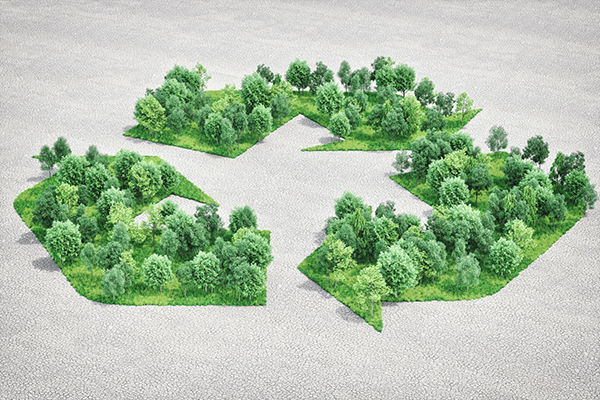How to Reduce Your Carbon Footprint
From upgrading your electronics to taking shorter showers, finding ways to live green requires some tweaks to your routine. If you’re a homeowner, there are many powerful options to help your home go green which can actually save you some green on energy bills.
 Did you know that just by upgrading your HVAC equipment to ENERGY STAR-qualified equipment, you could save nearly $200 on your annual heating and cooling bills? Or that homeowners who lease solar systems for their home report saving between $70 and $110 monthly on their electrical bills?
Did you know that just by upgrading your HVAC equipment to ENERGY STAR-qualified equipment, you could save nearly $200 on your annual heating and cooling bills? Or that homeowners who lease solar systems for their home report saving between $70 and $110 monthly on their electrical bills?
Your home’s heating system, electronics and even the landscaping are all areas where you can increase energy efficiency and save money. That’s why we’ve rounded up expert advice to help you reduce your home’s carbon footprint.
Proper Insulation
Making sure your home has effective insulation is a key factor in your heating and cooling system’s energy efficiency. In fact, 20% of your home’s cooling costs can be reduced through proper insulation.
But which kind of insulation do you need? Amy Todisco, nationally recognized green living expert of Green Living Now, suggests foam insulation.
“The energy savings is remarkable, and the comfort of living in a home that is airtight (without drafts) is wonderful,” Todisco says. “Plus, you can reduce your heating and air conditioning requirements, which means you use less fossil fuels.”
This applies to your windows and doors as well — poorly sealed windows and doors means cool air escaping from your home in the summer, and warm air in the winter. Todisco also recommends replacing “old, drafty windows with new energy efficient ones.”
But foam insulation isn’t always the best solution.
Alternative Heating and Cooling
Beyond a high-quality HVAC system and proper insulation, there are other methods to make your home more energy efficient. Geothermal heating and cooling systems reduce your home’s carbon footprint.
Year round, the temperature of the ground is more consistent than your home, because it absorbs 47% of the sun’s heat as it hits the Earth’s surface. Geothermal heating and cooling systems use this energy through technology that is often called an “earth loop.” This loop can either heat or cool your home throughout the year.
During the heating cycle, a geothermal heat pump uses the earth loop to extract heat from the ground, which is then distributed through your home’s duct system as warm air. The same heat energy can be used for your hot water heater.
To cool your home, heat is extracted from the air in your home and either pushed back into the earth loop or used to preheat the water in your hot water tank.
Learn 8 ways to stay cool this summer
You can also make specific decisions while building a new home to accommodate for natural heating and cooling systems. Window placement and natural shade-producing elements like trees can help warm and cool your home throughout the year.
“If you are building a new home, create a south-facing wall of glass for passive solar gain,” Todisco advises. “Have a roof overhang sufficient to block the higher summer sun so your home doesn’t overheat.”
Low-Energy Appliances
Replacing energy-guzzling appliances in your home is an effective—and cheap—way to reduce your home’s carbon footprint. From your lightbulbs to your microwave oven, an energy audit can help you find the inefficient appliances in your home that are wasting money and energy.
Kelsey Russell, tiny house renovation expert from Fort Collins, CO says the key “is to simply look at everyday appliances and their energy usage.”
But an energy audit may not always tell you exactly what you need to know. “Households that have gone solar sometimes just have an expert look at their utility bill and match the usage, yet they don’t investigate what items are using the most power.”
You need to look a bit more closely. “A homeowner that looks at everything in their home that consumes power and makes the change to more energy efficient appliances can drastically lower their carbon footprint,” says Russell.
Eco-friendly Landscaping
Water conservation boils down to a whole lot more than turning off the faucet while you brush your teeth and taking shorter showers. How you landscape your yard can play a huge role in how much water your home uses.
Xeriscaping is an easy and cheap way to reduce your home’s carbon footprint, especially in arid climates like the Front Range where keeping grass green is hard to do while trying to go green.
T.J. and Stephanie Wethington, owners of Denver non-profit Wealth in Community Knowledge say, “In our experience, one of the easiest and cheapest ways to reduce your carbon footprint is xeriscaping.”
“Outdoor water use accounts for approximately 55 percent of the residential water usage in the Front Range urban area, with the majority of the water being used to water lawns.”
So where do you begin when you want to xeriscape? “Simply removing most grass from your lawn can reduce your water usage significantly, especially here in Colorado where the summer tends be pretty dry.”
“You can start by replacing parts of your lawn with native Colorado plants such as yucca or flax and adding some rock or pavers for more design,” Stephanie Wethington states. “Not only do these plants require less water, but they are more resistant to pests and help restore Colorado’s natural habitat.”
Pro tip: To conserve water, get a rain sensor for your sprinkler system.
Natural Waste Management
“Reduce, reuse, recycle” is the mantra of every homeowner who wants to find ways to responsibly dispose of waste.
Matthew Shaw, program director at ReCreative Denver and co-founder of Wealth in Community Knowledge says, “One of my favorite things to recommend to reduce the volume of garbage leaving [your] house is composting. And recycling, of course.”
Composting is a popular method of reusing organic waste around Colorado, but some people may not realize that the benefits of composting aren’t exclusive to enriching your soil and keeping you from buying expensive fertilizer:
The average American family creates 650 pounds of compostable materials every year
Over 60% of waste in landfills is compostable, organic matter
Composting saves you money on garbage collection bills, and municipalities save money on the transport and disposal of compostable waste
If you’ve never composted before, don’t sweat it: all you really need is a place to put the organic scraps, and knowing what can and can’t be composted. Here’s how to start a compost pile in four steps.
“Composting on your own is not as daunting as it sounds and, depending on your diet, it could cut your waste by around 50%,” Shaw states. “If you have kids, it’s a real learning opportunity as well, illustrating how good soil is made and how important worms, bugs, bacteria, fungi, etc. are!”
Fans that can help keep you cool this summer >




